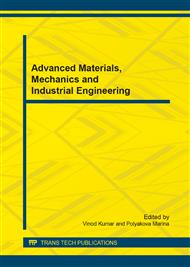[1]
Qing-ding Wei, Bo-yin Zhang, Ke-qi Liu, Xiang-dong Du, Xian-zhong Meng: A study of the unfavorable effects of wind on the cooling efficiency of dry cooling towers, Journal of Wind Engineering and Industrial Aerodynamics, Vol. 54/55 (1995) 633-643.
DOI: 10.1016/0167-6105(94)00078-r
Google Scholar
[2]
M. Goodarzi: A proposed stack configuration for dry cooling tower to improve cooling efficiency under crosswind, Journal of Wind Engineering and Industrial Aerodynamics, Vol. 98 (2010) 585-863.
DOI: 10.1016/j.jweia.2010.08.004
Google Scholar
[3]
A. F. Du Preez & D. G. Kroger: Effect of wind on performance of a dry-cooling tower, Heat Recovery Systems & CHP, Vol. 13, No. 2 (1993) pp.139-146.
DOI: 10.1016/0890-4332(93)90033-r
Google Scholar
[4]
M.D. Su, G.F. Tang, S. Fu: Numerical simulation of fluid flow and thermal performance of a dry-cooling tower under cross wind condition, Journal of Wind Engineering and Industrial Aerodynamics, Vol. 79 (1999) 289-306.
DOI: 10.1016/s0167-6105(98)00121-4
Google Scholar
[5]
Mohsen Goodarzi & Hossein Amooie: A proposed heterogeneous distribution of water for natural draft dry cooling tower to improve cooling efficiency under crosswind, 4th Conference on Thermal Power Plants, Tehran, Iran, IEEE (2012).
Google Scholar
[6]
Hossein Ahmadikia, Mohsen Soleimani, Ehsan Gholami: Simultaneous effects of water spray and crosswind on performance of natural draft dry cooling tower, Thermal Science, Vol. 17, No. 2 (2013) pp.443-455.
DOI: 10.2298/tsci110510134a
Google Scholar
[7]
M. Goodarzi & R. Keimanesh: Heat rejection enhancement in natural draft cooling tower using radiator-type windbreakers, Energy Conversion and Management, Vol. 71 (2013) 120-125.
DOI: 10.1016/j.enconman.2013.03.031
Google Scholar
[8]
ANSYS FLUENT 14. 0, User's Guide, ANSYS, Inc. Southpointe 275 Technology Drive Canonsburg, PA 15317 (2011).
DOI: 10.1016/b978-0-12-811768-2.00022-5
Google Scholar
[9]
Amir Hozhabr, A. R. Tahavvor, S. Samimi: Numerical simulation of flow field between gas turbine blades, GE F9 model, 4th Conference on Thermal Power Plants, Tehran, Iran, IEEE (2012).
Google Scholar
[10]
Gebhart B: Buoyancy-Induced Flows and Transport, Textbook ed. Hemisphere Publishing Corporation (1988).
Google Scholar
[11]
Launder BE, Spalding DB: The numerical computation of turbulent flow, Comput Meth Appl Mech Eng, Vol. 3 (1974) 269-289.
Google Scholar
[12]
EGI. The Heller System. Budapest (1984).
Google Scholar
[13]
EGI. Thermo Technical and Aerodynamic Design/Calculation/Characteristics of the Dry Cooling Plant System Heater, Budapest Institute of Engineering (1985).
Google Scholar
[14]
Azimian AA, Shams K, Khojasteh A: Simulation of wind effect on dry cooling tower, 9th ISME2005 Conference, Isfahan, Iran (2005).
Google Scholar


